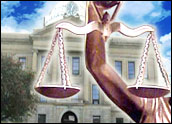
For six years Australia-based security software company Uniloc and Microsoft have duked it out in the courts over charges that Microsoft infringed on Uniloc’s patent. A jury said it did and awarded Uniloc what was purported to be the fifth largest patent verdict in history. However, in a 66-page decision, Rhode Island’s District Judge William Smith overturned the US$388 million verdict and unceremoniously handed victory to Microsoft.
“After careful consideration of the arguments and the evidence, the Court grants [a judgment] of non-infringement in Microsoft’s favor,” Smith wrote.
His reasoning? In a nutshell, the jury didn’t understand the technology — or the law as it applied to that technology.
Unlicensed Use
The patent in question, issued on Feb 6, 1996, is a “system for software registration,” according to the ruling. In broad terms, it is a method of reducing unlicensed use of software through unauthorized copying by locking the software to a user and allowing it “to run in a use mode on a platform if and only if an appropriate licensing procedure has been followed.”
Microsoft allegedly infringed Uniloc’s patent in its Product Activation system — a feature in software products including Microsoft Office XP, Windows XP and Office 2003 — which aims to limit the number of computers on which software can be installed under the applicable product license Agreement.
Uniloc sued on September 26, 2003. After several twists and turns through the courts — starting with a summary judgment in Microsoft’s favor in October 2007, which resulted in Uniloc narrowing its case to two claims — the case finally went before a jury. In April, it returned its eye-popping verdict.
A renewed judgment as a matter of law — which is what Smith issued — is appropriate when “a party has been fully heard on an issue during a jury trial and the court finds that a reasonable jury would not have a legally sufficient evidentiary basis to find for the party on that issue,” he wrote.
“Basically, the judge was acting as the 11th juror to decided that no reasonable jury could have come to this conclusion,” Darryl Woo, partner and litigation chair with Fenwick & West, told the E-Commerce Times.
Evidence Wasn’t There
Having a jury verdict overturned is rare in a traditional case — but it does happen more often in cases involving technology or taxes or some other complex subject.
“When there are technical issues at the heart of a case, it can be difficult for a jury to follow,” Christopher M. Collins, partner with Vanderpool, Frostick & Nishanian, told the E-Commerce Times.
On appeal, cases can be overturned when a participant asks the court to look through the actual evidence, he said.
Uniloc has very creative arguments concerning the jury’s role in considering evidence — including the court’s decision to permit such consideration — but the court ultimately found that no reasonable jury could find direct infringement based on the evidence presented, Collins said.
“In other words, Microsoft’s argument that the jury simply did not follow the evidence properly is what the trial court agreed with,” he explained.
The judge was able to do this based on procedures established in Rule 50(b).
“Basically, under that rule, the court can overrule the jury verdict if it concludes that no jury could have found for a party under the evidence presented as a matter of law,” said Collins.
One to Go
With the Uniloc case all but over, Microsoft has just one other major lawsuit hanging over its head.
i4i claims that Microsoft has infringed on its technology incorporated in Word. Judge Leonard Davis of the U.S. District Court for Eastern Texas issued an injunction against the sale of the software in in mid-August and ordered Microsoft to pay $240 million in damages.
However, at the beginning of September, the U.S. Court of Appeals for the Federal Circuit temporarily stayed the injunction against the sale of Word, which had been set to go into effect in October.













































Social Media
See all Social Media